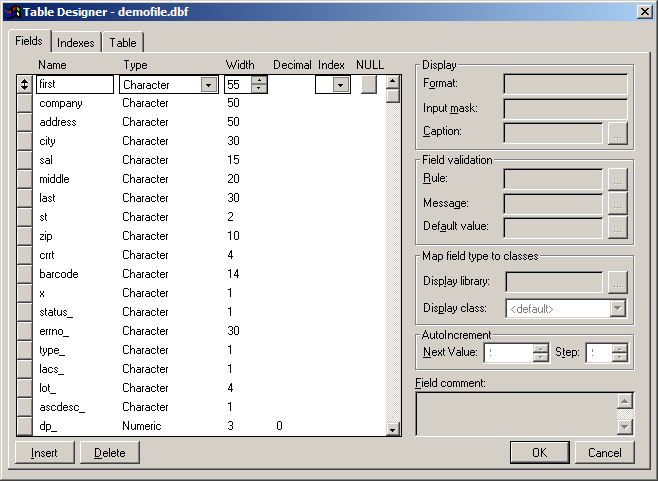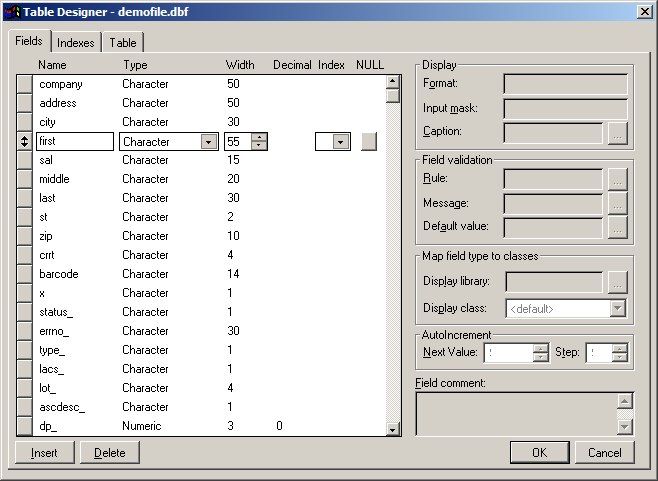
In the Table Designer you can insert and delete fields or change the name, type or width of the fields in your list. Field names can be up to 10 characters in width. A field name should begin with a letter, a-z, and not contain any spaces or punctuation except for an underscore character, i.e. Shift+Dash. See AccuZIP6 Field Descriptions for a list of common AccuZIP6 field names and information on required fields.
Follow the steps below to Edit the Table Design:
From the Edit menu, choose Fields.
The Table Designer dialog box will appear.

To Insert a new field:
Position the cursor in an existing field and click Insert.
A field named NEWFIELD will appear with a Character Type and a default Width of 10.
Type the desired name of the field and press Tab.
From the Type pop-up choose a data Type and press Tab.
Data Types are explained in detail below.
Adjust the Width of the field as desired
To add additional fields, repeat the steps above.
To Delete a field:
Position the cursor in the field that you want to Delete.
Press the Delete button.
The selected field will be removed and all the remaining fields shift up one position in the structure.
|
TIP! |
A Before deleting a field, be sure that you have chosen the correct field name. This function will permanently delete the data in the field. |
To change the name, type or width of a field:
Position your cursor in the field that you want to change.
Make the desired changes.
Click OK.
Click Yes to make the Structure Changes Permanent.
|
TIP! |
If the data type that you’ve chosen has a variable field width, a spinner appears under the Width heading. You can change the default value by clicking the spinner control or by entering a width for the field in the Width text box. If the data type is Numeric or Float, a spinner appears under the Dec heading. You can change the number of decimal places the field will have by using the spinner control or by typing a number in the Dec text box. |
Data Types:
Character
Use Character fields to store text information such as names, addresses, and numbers that will not be used in mathematical calculations, such as, prices, quantities, and sales amounts. Character fields have a default width of 10 and can be a maximum of 254 characters.
Numeric
Numeric fields store numbers that will be used in mathematical calculations, such as, prices, quantities, and sales amounts. Numeric fields have a default width of 20 and can be a maximum of 20 digits.
Float
Float fields specifically store scientific data. Float fields have a default width of 20 including an optional plus/minus sign and decimal place.
Date
Date fields store dates in a date format. Date fields have a default width of 8: 2 digits for day, 2 for month and 4 for year. Dates will be displayed with a forward slash separator in the field.
DateTime
DateTime fields store values that are either dates or times, or both. DateTime values can contain both a date and a time, or only a date or only a time. The DateTime field has a width of 8.
In both Date and DateTime data types, the following rules apply:
{00:00:00AM} is equivalent to {12:00:00AM}, Midnight.
{00:00:00PM} is equivalent to {12:00:00PM}, Noon.
Logical
Logical fields store matter of fact information about the record. AccuZIP6 requires a, "T" for true and "F" for false. Logical fields are always 1 character in width.
Memo
A Memo field is a reference to a block of data. The default width of a Memo field is 10. However, the actual size of a Memo field depends on the amount of data entered into it. Memo field sizes are limited only by the amount of available disk space.
General
General fields store OLE objects. The default width of a General field is 10. However, the actual size of a General field depends on the amount of data entered into it. General field sizes are limited only by the amount of available disk space.
Picture
The Picture field type exists for compatibility with FoxBase+® and is dimmed unless you open a database created in FoxBase+ that contains a picture.
Currency
Currency fields store currency data. Use the Currency field type instead of Numeric for monetary values. If you specify more than four decimal places in a currency expression, AccuZIP6 rounds to four places before evaluating the expression.
Integer
Use the Integer field type for non-decimal numeric values where performance and table storage limitations are especially important. In tables, the integer field type is stored as a 4-byte binary value so it requires less memory than other numeric data types and, as a binary value, requires no ASCII conversion.
Double
Use the Double field type instead of Numeric when you need more accuracy, a fixed amount of storage in your table, or true floating-point values.
Reordering the Table Structure:
You can permanently change the default order that the fields appear in the Table Designer dialog box. This will reorder the structure of the database and make it the List View Default.
|
TIP! |
Moving the fields around in the Table Designer will not affect your current View of the database. You must choose List View Default from the View menu to see your list in order based on the structure setup in the Table Designer. |
Follow the steps below to reorder the fields in the Table Designer:
In the Table Designer, click on the field that you want to reorder as shown below:

Position your cursor in the gray box to the left of the field where the double arrow appears and click and drag the field into the desired order.
|
TIP! |
When indexes are created in AccuZIP6 they appear under the Index tab in the Table Designer. Indexes are created when you sort by a field in the list. For more information on Indexing and Sorting see Sorting by Field Names. |